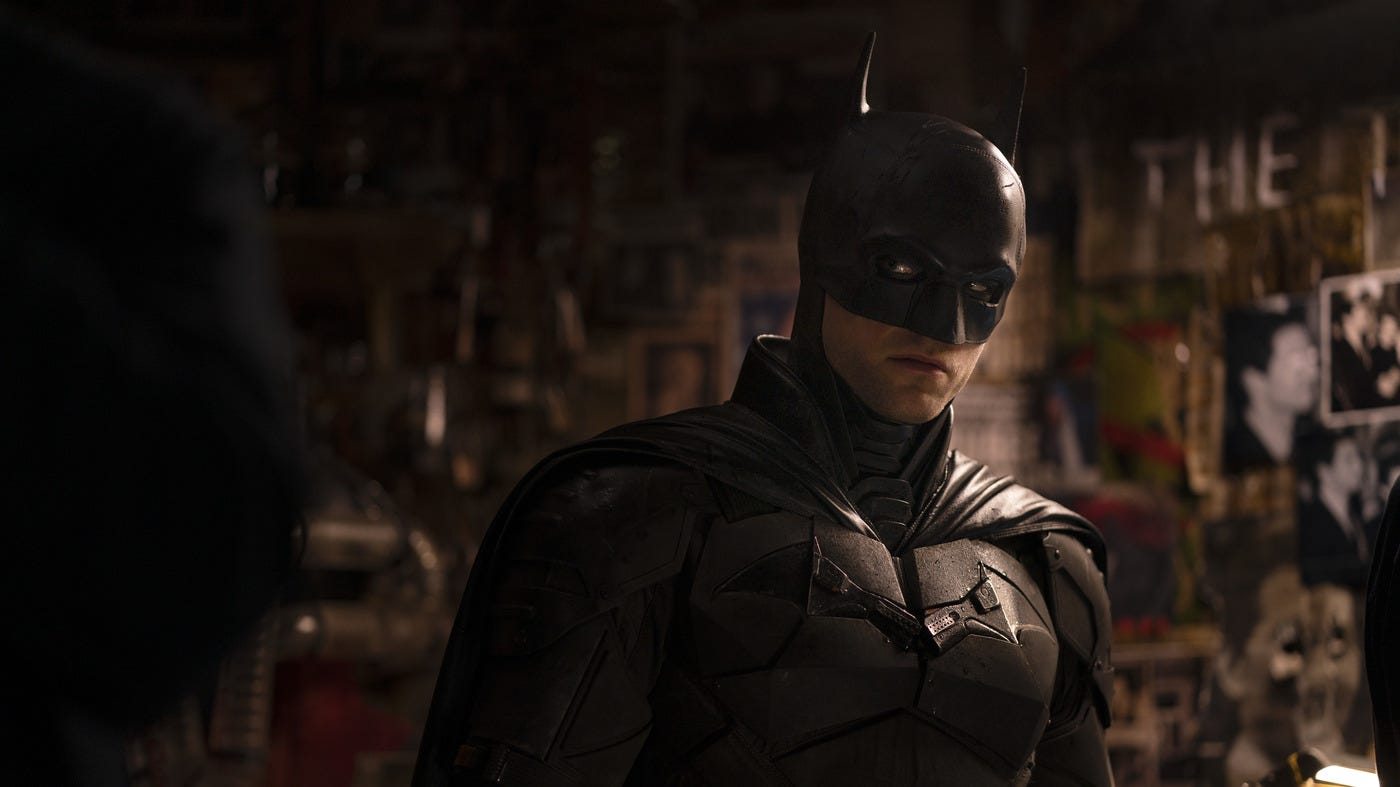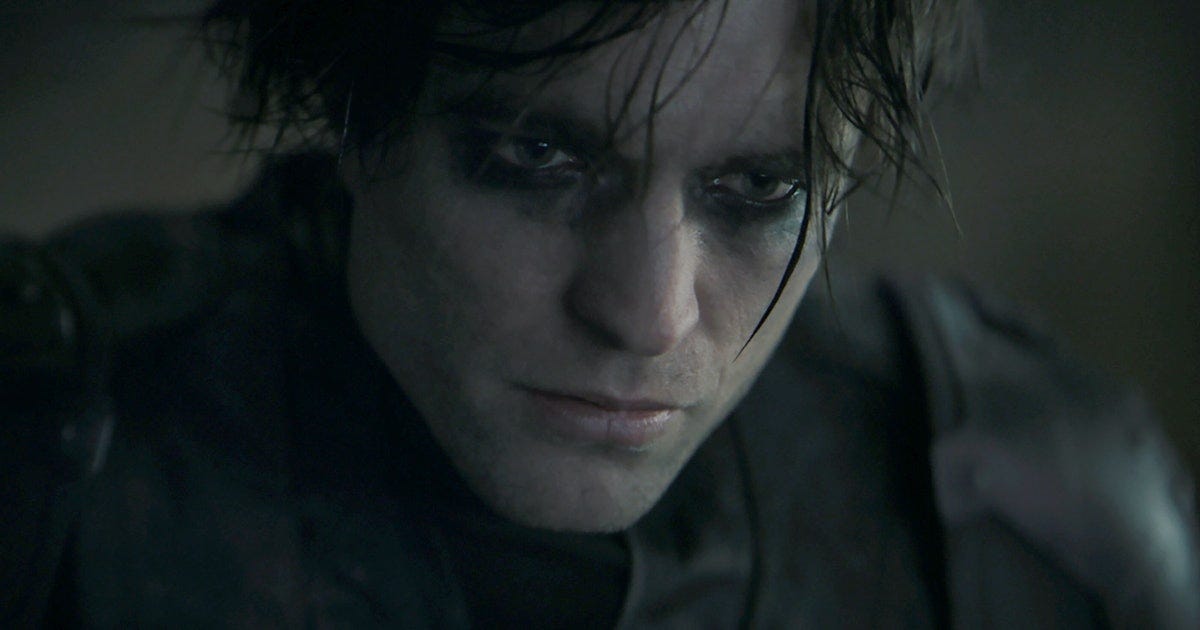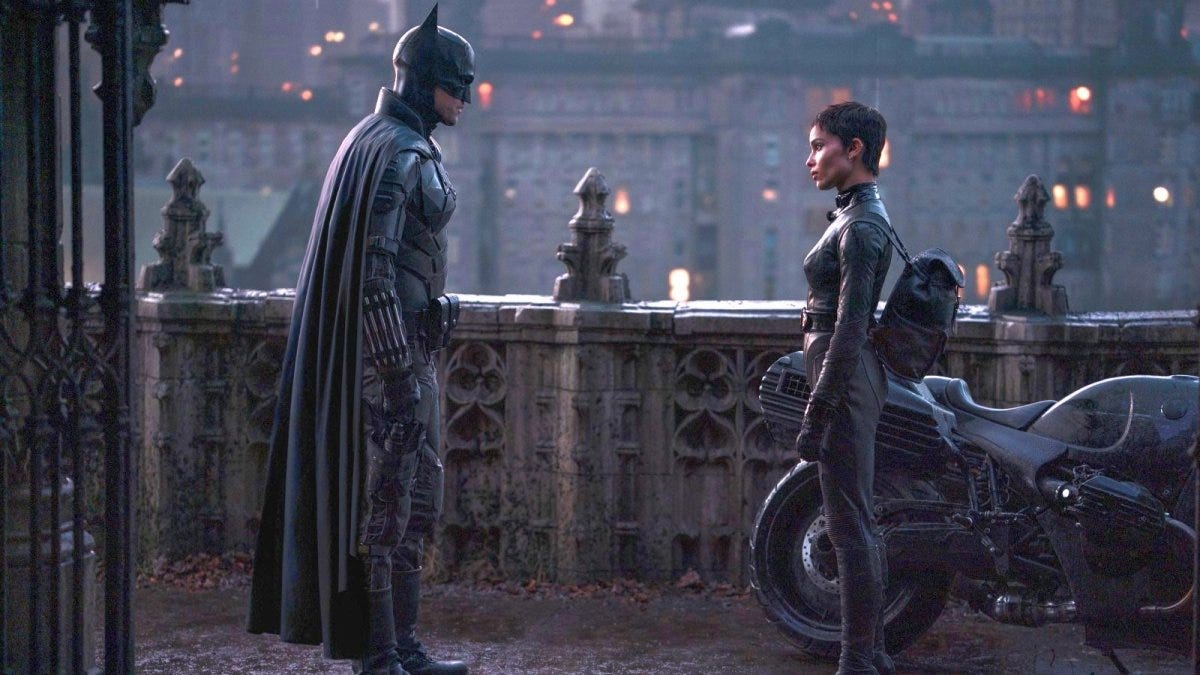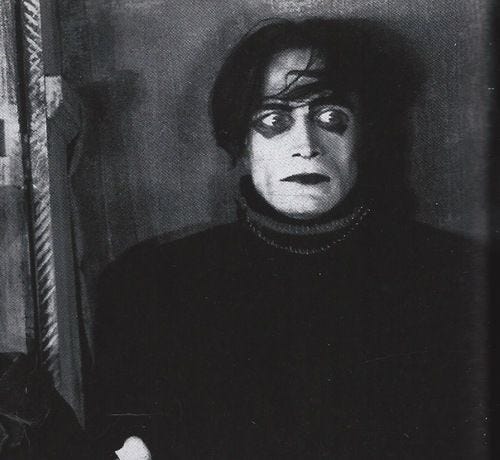"The Batman": Graphic, Novel
Director Matt Reeves and star Robert Pattinson take the Caped Crusader all the way into the dark.

The Nut Graf1: Tired of Batman movies? Me, too. But “The Batman” (in theaters March 4, *** stars out of ****) for once gambles the franchise on a genuinely dark vision.

Batman movies have been dark for years – it’s been the house brand ever since Tim Burton set up shop in the wake of “The Dark Knight” comic books of the late 1980s. Matt Reeves’ “The Batman” is the first Batman movie to feel not just dark but diseased, like something unclean teetering on the edge of an apocalypse. This is what makes it interesting and, in a number of places, very good. It lands in theaters this Friday.
I know, I know — I said when I started this newsletter I’d be steering clear of writing about anything involving capes, superpowers, doomsday countdown clocks, or the digitally animated destruction of a major urban center. I also said there’d be exceptions. And, yes, the DC/Warner Bros. “Batman” franchise has become self-serious to the point of pomposity in recent years, starting with the Christopher Nolan/Christian Bale “Dark Knight” trilogy and descending into the Zack Snyder cycle featuring Ben Affleck as an outer-borough Batman so depressive he can’t work up the energy to shave. The latter movies especially have felt grandiose but inert, fetish objects carved in concrete and designed for maximum profit.
But I was interested in the new movie because A) Robert Pattinson, like his “Twilight” co-star Kristen Stewart, has become one of the more mercurial, risk-taking actors of his generation (not to mention a man who treats lying as a performance art), and B) Matt Reeves is the filmmaker who brought the “Planet of the Apes” films back to life with such vision and vigor. You can tell when one of these blockbuster directors brings actual originality to an IP-content behemoth, because it tends to piss off the hardcore fans. Viz., Rian Johnson’s “The Last Jedi,” which was the best-directed “Star Wars” installment by a long shot, but which made the “mistake” of inviting gurls to play along. “The Batman” has already split critics as well as early audiences into opposing camps because – well, why?

Because it reimagines Bruce Wayne/Batman as a pallid, reclusive emo kid who might be somewhere on the spectrum? Because its depiction of a prostrate megalopolis on the verge of being crushed by corruption and the waters pounding at its seawalls is genuinely nightmarish? Because in its darkness and constant downpours Gotham City has never looked more like “Blade Runner”? Unlike any previous “Batman,” this one has tendrils that creep into the world outside the movie theater and connect to the dread some of us have that things might be too far gone to ever be set right. That the stain has spread too far and has roots too deep; that the killer is in the house. Or maybe I say that because I’ve read the headlines this morning.
The plot is quotidian as these things go. There’s an arch-villain who calls himself the Riddler and who is picking off the corrupt officials of Gotham City with baroque death-traps and word games, but he seems a psychopathic sideshow to what’s essentially a gangland turf war where one of the gangs is City Hall. (When the Riddler is ultimately identified, it seems a letdown despite the talents of the actor playing him; the character’s backstory and motivation seem to have been left on the editing room floor.) The Penguin is here not as a waddling Burgess Meredith or a scuttling Danny DeVito but as a Capone-esque gangster played by a well-known actor so transformed by makeup that I barked in surprise when I read his name in the end credits. (I like to go into these things cold.) For all that, the most dangerous character in the movie is an old-style mob boss played by John Turturro, who is not usually this scary.

Or maybe the most dangerous character in the movie is Selina Kyle, a.k.a. Catwoman, as portrayed with wit, agility, and a pulse by Zoë Kravitz, here keeping faith with such sainted forebears as Eartha Kitt, Julie Newmar, and Michelle Pfeiffer. With a Batman this emotionally constipated, someone has to bring the fiber, and it’s not going to be Jeffrey Wright’s beleaguered Commissioner Gordon. Kravitz is really the only person here who suggests there might be life outside Gotham City, that daylight might come, that it might stop raining. That Batman someday – someday – might have sex, or might want to, instead of sitting around the Batcave like a sadboy Symbolist poet.

But that makes it sound like I’m shortchanging Pattinson’s performance, when he’s the key to why “The Batman” feels truly unpredictable, as if it might lurch off the screen and roll into the audience like a thrown tire. Unlike Michael Keaton’s generally spiffy Bruce Wayne or Christian Bale’s brooding hunk or even Affleck’s exhausted civic leader, Pattinson’s Batman is a lost boy who’s somehow found himself in a batsuit (and can throw a roundhouse punch that would flatten a bull, but never mind). When he returns to the Batcave (and, really, it’s a mystery how this overgrown kid found enough Legos to build it) and takes off the cowl, his hair and eye makeup are a post-punk mess and Alfred (who I thought for half the movie was Kenneth Branagh before realizing it was Andy Serkis) has to clean him up. As Bruce Wayne, he’s almost too terrified to leave stately Wayne Manor, which is envisioned by production designer James Chinlund as a bleak Gothic version of New York’s Dakota inhabited by a sole tenant. More than ever, Batman’s heroism is a symptom of his dysfunction, in ways that Frank Miller, the author of the original “Dark Knight” comic books, might appreciate.
That gloomy, half-glimpsed production design carries all the way through “The Batman,” making it perhaps the first example of neo-retro-postmodern German Expressionism. I’m not half-kidding when I say that Fritz Lang would look at this movie and see his Metropolis, ruined but recognizable, or that Pattinson could be first cousin to Conrad Veidt’s somnambulist in “The Cabinet of Dr. Caligari” (below). The star deglamorizes his superhero the way you might deglaze a pan; he un-mans him in a way that feels new and weirdly refreshing (while having the side benefit of freaking the fanboys out).

The last thing I’ll say about “The Batman” – and, really, you already know if this is your cup of corporate theme-park hemlock or not – is that Reeves does something unusual for a superhero movie. He personalizes the crowds. Usually, the masonry will start falling or the Eiffel tower will explode or the arch-nemesis will bring down a jumbo jet just to show he means it, and all those deaths are just … collateral pixels. We’re not meant to think about them as people, individual lives, because if we do, that might spoil the fun, and if the fun gets spoiled, nobody makes any money. In this movie, a number of the most suspenseful action scenes take place in large, enclosed spaces with extras and secondary characters we’ve seen enough times for them to become familiar – a funeral for the mayor (Rupert Penry-Jones), with the entire power structure of Gotham City present before the Riddler sends in the District Attorney (lonesome Peter Sarsgaard as the unluckiest civil servant in recent memory) to try to blow everything to smithereens. And in the final sequence, Reeves visualizes a city’s spiritual collapse by way of a climate change metaphor that you may realize – in the part of your brain where you put things you don’t like to think about – isn’t really a metaphor at all.
I’m making it sound like “The Batman” isn’t much fun at all, and guess what – it’s not. That’s what makes it worthwhile. Even the Nolan movies delivered a boo-yah adrenaline rush while parading their glib nihilism; the combination is why they’re beloved. Reeves stages plenty of mayhem, all right, but you don’t feel like cheering. On the contrary, you feel like holding on to the two or three or four characters in this movie who might remember a world outside the hellhole of Gotham City and how people treat each other there. “The Batman” is a comic book movie for an audience finally getting ready to read something else.
If you enjoyed this edition of Ty Burr’s Watch List, please feel free to share it with friends.
If you’re not a paying subscriber and would like to sign up for additional postings and to join the discussions, here’s how:
If you’re already a paying subscriber, I thank you for your generous support.





